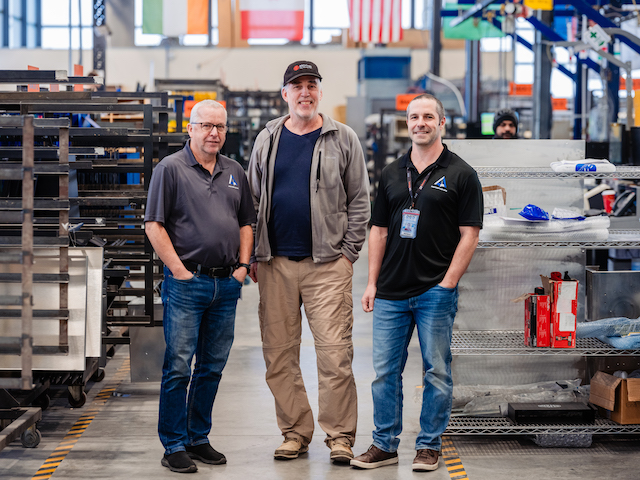By Joe Tito
We report on a plethora of new processing and testing tools on these pages. It’s no doubt harness manufactures today need to have a wider range of specialized equipment in their arsenal to meet emerging challenges. You folks are working on products that never existed and on programs that were only dreams just a few short years ago. But it takes more than just the introduction of new technologies into harness shops to compete in this environment. It’s also imperative to develop partnerships with outside vendors to strengthen the value-add abilities that make you a more useful provider of solutions.
That’s why we jumped at the chance to interview Protocase co-founder Steve Lilley. At its heart, Protocase, and their aerospace division ProtoSpace, manufacturers custom sheet metal and CNC machined electronic enclosures, mounting hardware, and miscellaneous components for the electronics industry. Steve was eager to talk about his experience with the harness industry and what Protocase has to offer. We also discussed their free online drawing tool, and the company’s new US facility.
“I’ve got some wire harness background,” Steve began. “I worked for a company about 35 years ago, that did contract manufacturing for the Canadian and British navies. A big part of what we did was electronic assembly, including wire harnesses.” Ten years later, Steve and his business partner Doug Milburn started Protocase recognizing the importance of serving an untapped market for low-volume custom sheet metal, machined, and plastic parts to service the electronics industry. “I saw that a lot of manufacturers were moving to higher reliability parts and the time latency was a big problem. These folks needed to get their products to market quickly.” So, Steve and Doug positioned Protocase under the concept of mass customization.
Mass customization combines the flexibility of customized products with the efficiency of mass production techniques. It allows Protocase to produce goods that are tailored to individual customer requirements, while still benefiting from economies of scale typically associated with large-scale production. The approach often involves advanced manufacturing technologies, such as flexible automation and digital production methods, to achieve cost-effective customization. “We automate every repeatable process or work element; then only feed custom parts through manual parameters,” Steve explained. He used the simple example of powder coating, a service they offer to customers. “Traditionally that was very craft oriented and done by someone who’s got a very steady hand. But there’s so much of that process that is repeatable. All the parameters can be programmed into a machine. Now, the only custom perimeters are color and texture.”
By reducing all possible time latency in the custom production process, Protocase is giving their customers the ability to be iterative. “The customer can be in the mindset of, ‘OK, I’m going to take a shot at this design, it’s going to be done very quickly for me, and I’m going to be able to turn it around and test it. If it doesn’t work, that’s OK because we can always do another quick iteration,’” Steve explained. “In short, it gives our customers the ability to design and build things more efficiently and cost-effectively.”
Ironically, for the company’s wire harness customers, enclosures are only part of the equation. “I took a quick look at wire harness customers in our database,” Steve noted. “A lot of them are using us to make custom brackets they use to route harnesses within enclosures.”
Protocase has come up with a sophisticated and easy to use online tool to help their customers design the parts they need. “We make metal parts and that’s in the mechanical world. Most of our customers come from the electronics world and are not knowledgeable in mechanical design. We created a tool called Protocase Designer which is a light template-based enclosure and bracket design program that we offer to our customers on our website free of charge. It’s designed around our manufacturability constraints so if they can build it with Protocase Designer, we can make it,” Steve detailed.
When helping to design a new product, Steve mentioned Protocase is always thinking about the handoff to larger volume production. “Often, as customers develop through the design process, they think they’re going to go from prototype into mass runs of 1,000, 10,000 or 100,000 units. But that’s not the way it works in real life. What we’ve done is offer what we call mid-volume runs that make it really easy and convenient for the customer.” He described the typical scenario where a customer has the design tested and ready to go. “They really only want 10 initially, then 10 the next month and ramping from there. So, we will agree to a mid-volume run of 100, 200, or 250 units. It allows them to get to the stage where they can leave us and go with the efficiencies of larger manufacturers with molds or other technologies outside our space.”
The discussion turned to the types of materials Protocase works with. “We have our sheet metal division which can handle material up to a quarter inch thick with all grades including aluminum, mild steel, galvanized steel, and stainless steel. And then on our machining side we do aluminum and a wide variety of steels,” Steve described.
Protocase also does extensive work with lighter materials like plastics. A driving force for that is the development of electrification in aviation. “It’s another emerging sector and one where weight constraints are an important factor. We’ve become very efficient and lean in terms of materials in the parts we are producing for the electric aviation world.”
For quick turnarounds on prototype or small lot orders, the company does a lot of stereolithography with polymers and can 3-D print parts to fit within electronic enclosures, and other applications.
More recently, Protocase has done a lot of work with copper busbars. “This is a quickly emerging piece of our business,” Steve outlined. “We are currently looking at a variety of different plating techniques on copper busbars as the requirements develop. We are also finding new requirements for much heavier gauge copper busbars”
Steve talked about the size range of products they produce. “If you were to look at what we could build from a single piece of sheet metal, 6’ by 12’ is about the largest sheet we could do. But when I walk on the floor, I typically don’t see anything larger than probably 6’ by 6’ by 3’, and even that’s a stretch for us. And of course, with the other materials, we can do very small enclosures.” Protocase pushes about 150 orders out the door every day. “Each one is unique…each one is custom.”
Protocase has around 400 employees and Steve reckons that’s big enough to cover the wide variety of products they bring to market, but small enough that he knows most of their names. They are ISO 9100 and AS 9100 certified and adhere to ITAR controls. They build to NEMA standards but because Protocase is not doing the final assembly, it’s up to the customer to do the actual NEMA certification.
Steve mentioned the AS 9100 certification was necessary for their aerospace customers they service through the ProtoSpace division. “The value proposition is no different with our aerospace customers versus our regular customers. It’s just that the aerospace world comes with a lot more documentation requirements for ITAR, AS 9100 and even data security requirements like the NIST 800-171, and CMMC.” Steve said they came to the realization there was a lot of value in being able to provide those services under a separate umbrella.
Protocase/ProtoSpace services all customers from their Sydney, Nova Scotia facility with a business office in Lewiston, NY. But what Steve was most excited to talk about was the addition of a new US manufacturing facility. “We went through an extensive selection program to determine where the facility should be, and we settled on Wilmington North Carolina. We are going to use a phase-in approach. Having secured our space, we are starting with some reselling activity. We will be adding some engineering services, then build our manufacturing presence there. It’s probably two years down the road before we get to that level, but then the sky is the limit!”
If you have an inquiry for Protocase or ProtoSpace, you can jump on their website at protospacemfg.com. As mentioned, their design tool is available for use free of charge and with no obligation. If you’d like to talk with Steve about a specific project, he invited you to contact him directly at [email protected].

————































































